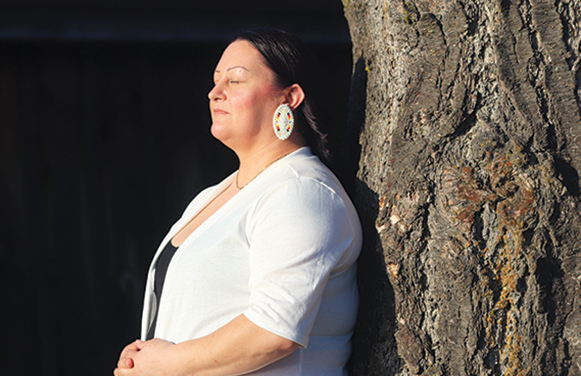
By Micheal Rios, Tulalip News
There’s been a surge of Native American communities across the country embracing the concept of wellbriety. In its purest form, wellbriety is a culture-centered movement that goes beyond sobriety to include holistic healing, cultural reconnection, and community empowerment. Rooted in tradition, wellbriety offers a culturally resonant approach to recovery, addressing not just substance use but the deep-seeded historical trauma that often underlies addiction.
Back in the summer of 2023, Tulalip’s Family Services and Problem Gambling program partnered up to bring the wellbriety movement back to Tulalip. After an exclusive training called the Medicine Wheel and the 12 steps, created by Native American nonprofit White Bison, the wellbriety movement was officially relaunched within our reservation.
“Hopefully [the concept of wellbriety] helps bring a better understanding because it talks a lot about intergenerational trauma,” explained licensed chemical dependency counselor, Robin Johnson. “So, with a better understanding of that and also their own family dynamics, this gives them an understanding of where it started, why it’s happened within their families, and why it continues to happen.”
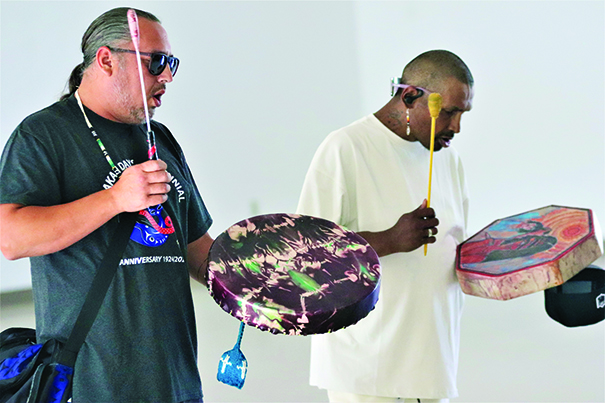
By providing that must-needed understanding that lays at the root of the cause, wellbriety aims to arm adults with the power and cultural know how to take back control of their lives. They are first taught how, then empowered to re-chart their lives with healthy choices and healthy behaviors.
“What sets [wellbriety] apart is the medicine wheel. You do the steps in a circle,” Robin further explained. “In the linear way, when you relapse you start over. In A.A. or N.A., you start over. But with the medicine wheel, it’s a continuous circle, so you continue moving forward. That makes a huge difference.”
Continuing to move forward could’ve been the theme behind the most recent wellbriety celebration hosted at the Kenny Moses Building on August 2. An estimated 80 individuals came together to create an atmosphere of strength and support for their peers who are actively working towards wellbriety for the first time, tenth time, or wherever they may be within circle.
One of the defining features of wellbriety is its emphasis on community and family support. Programs often involve not just the individual in recovery but also their family and community members. This collective approach creates a sense of shared responsibility and support, which is essential for sustained recovery and well-being. With that in mind, the most recent wellbriety celebration began in traditional communal fashion. First with a healing song offered up by Andrew Williams, followed by Helen Gobin-Henson prayer.
“These events, whether sobriety-based or wellbriety-based, are so beautiful because they continue to bring those who are in recovery together. They are giving the families an opportunity to celebrate the changes they’ve made to their lives and all their accomplishments they’ve made along the way,” acknowledged Helen. She’s been a sponsor to so many over the years its impossible for her to even guess a number, but one number she does know exactly is the number of years she has clean and sober – a whopping 36 years.
“We gather to celebrate every day these young people have chosen the red road and to be in recovery. We gather to show them support and serve as the reminder they may need that they are not alone in this journey, no matter how difficult it might seem, they are not alone. Because we can do together what we can never do alone,” added the Tulalip matriarch.
The ultimate goal of wellbriety is to restore harmony within families and communities. This is achieved through activities that promote collective healing and the strengthening of supportive relationships. By focusing on the well-being of the community as a whole, wellbriety creates an environment where individuals are more likely to succeed in their recovery journeys.
On this particular evening, five inspirational individuals, all of whom are well on their way to wellbriety, took to the middle of the Kenny Moses Building floor one by one. Each offered up their stories of struggle, hitting rock bottom, and recounting the resources they implemented to find their way back.
Desiree Dumont (42)
“In the beginning, the hardest part of my recovery was accountability because it was never my fault. It was always someone else’s fault. It took a lot of acceptance, a lot of encouragement from my community, and many long looks at the person in the mirror. An ankle monitor didn’t stop me from using. Jail didn’t stop me from using. It wasn’t until I saw how hurt and unhappy my kids were; the moment I recognized that I was the cause of their pain and in that moment, I couldn’t blame anyone else but me. I got clean for them, but along the way I realized how much I really wanted to change myself for the better.
I didn’t want to live the rest of my life with that anger and pain that always needed to be numbed away because if I did, then I could pass it on to my children. I stand before you all now a different person than I was 18-months ago. My consistency to be clean and sober is allowing me to make a better life me for me and my children. I’ve regained my license, a bank account, and, most importantly, custody of my kids. I’m a better mom and a better Desiree.”
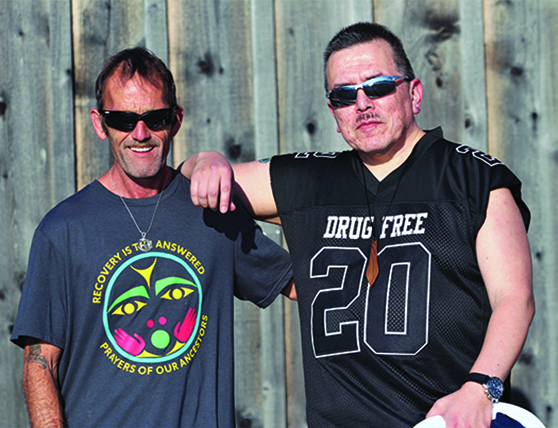
Mitch Matta (46)
“I got clean and sober exactly 650 days ago. Like most of you, I was brought into this world watching people around me use. My father was my hero. I grew up watching him drink at least a fifth of his favorite drink R&R every day. I watched as his skin turned yellow from Jaundice. Eventually, he died of Cirrhosis of the liver in 2009. My father, my hero lost his battle to the bottle. After he died, it was easy for me to pick up that lifestyle.
I just want to stress that for me, and many others, social isolation is the trigger to use. If you know anybody who is in recovery and is in a state of isolation, then reach out to them. You have no idea how much it means to know people care. A simple phone call or text asking “how are you?” could mean the world to somebody.
After I got my year clean, my daughters moved back in with me. Their support gives me the strength to stay clean. I want to be their hero, like my dad was to me. I still have my difficult days, and when those days happen I’m thankful for my counselor Robin Johnson, the staff at the Recovery Resource Center, and the Healing Lodge. Their willingness to listen and offer encouragement is good medicine. So much so that I want to open my door to anybody and spread the word of recovery and ensure that my life revolves around being clean and sober.”
Janelle Lierman (50)
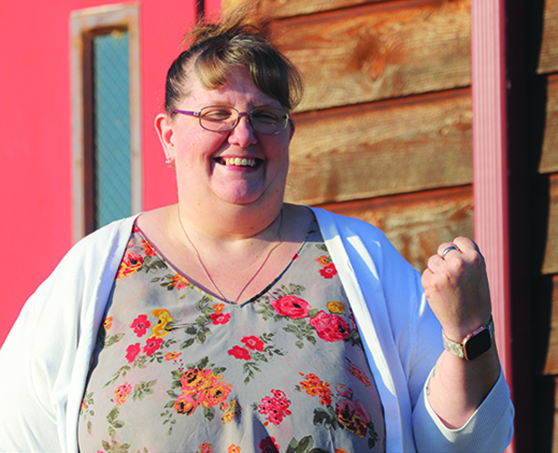
“We’re in recovery because we chose moments of fake happiness over real happiness. Fake happiness being those fleeting moments of being high, drunk, or winning at the casino. But that fake happiness is the occasional byproduct of a much larger set destructive, addictive, and life consuming behaviors that we ultimately could not control. That is why we’re in recovery.
When I was gambling, all I thought about was when I could get back to the casino again and where I could get more money from. I often gambled away my entire pay check, every week. I lied to everyone to cover up where I was and what I was doing. But at some point, each of us has decided that we had enough. Whether it was an intervention by those who love us, a criminal offense, or a near death experience, something made each of us realize we had a problem and needed to do something about it. For me, it was getting fired from my job and having to come clean to my husband.
I attend 5 to 6 recovery-based events every week because that’s what works for me. I’m very proud to say that I’ve been sober for over 15-months. The road has been anything but easy, and it’s a road that I will travel the rest of my life. I’ve learned that loving myself and forgiving myself is the first and most important step to finding healing and forgiveness in the relationships that I damaged with my addiction. I didn’t become a compulsive gambler overnight. I spent nearly 15 years and hundreds of thousands of dollars feeding my addiction. It would be unrealistic to think recovery would take any less dedication. Now, honesty, open-mindedness and accountability are the key words of my recovery.
Verle Smith (58)
“At the beginning it was a struggle. I didn’t know which way to go. I had to give it to my higher power, listen up and work on myself. It slowly got brighter. There have been struggles, I’ve relapsed multiple times, but I continue to brighten up and just punch forward.
My daughter is here with me today. You have no idea what this means to me. I now have the opportunity to be around family and to really find a sense of inner peace on the water. I love it. I still struggle today, but every morning I have the opportunity for another day, so I’m living it one day at time.
If it wasn’t for the Wellness Court, I don’t know where I’d be, if I’d even still be here. They gave me the opportunity to experience something that works for my life and I’m grateful for it. I do my mediation prayer and I believe that’s the key, make sure you say your morning prayers. I talk to a lot of people every day, like my best friend. Him and my family are my inspiration to fight harder for other people who need it. I love that people still have my back after everything.”
Christopher Solomon, (49)
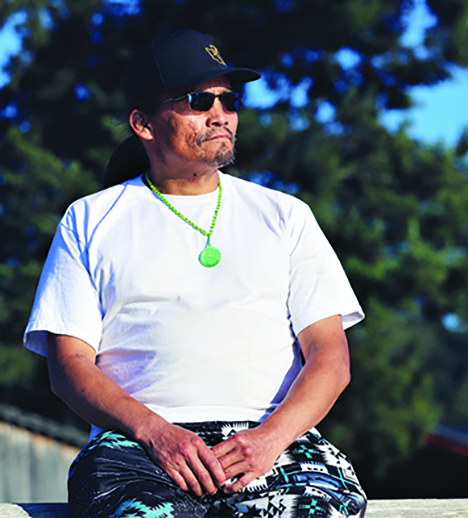
“I’ve been in and out of treatment since I was 15-years-old. When I was growing up, I thought drinking and using drugs was normal. I remember watching my mom put alcohol in my siblings’ bottles and thinking ‘if she is doing that to them, then she did that to me.’ They’d have these huge parties at their house or my aunt’s house. There would always be a big stack of beer and it would all be gone by the end of the party
Drinking was so normal for me my entire life. Getting drunk, then sobering up just to get drunk again. I’m trying to make being sober normal now. My clean date is 12-26-23.”
The impact of wellbriety on our community is profound as evidenced by the truth to power spoken by Desiree, Mitch, Janelle, Verle and Christopher. Through the dedicated staff of Family Services, Problem Gambling, and the Recovery Resource Center, a culturally relevant and empowering path to recovery is now more accessible than ever before. Through wellbriety, individuals struggling with addiction can find a renewed sense of purpose, cultural connection, and hope for the future.
Concluding, the wellbriety celebration was a countdown of days sober. Collectively, there was nearly 340 years of sobriety within the Kenny Moses Building’s walls. The next wellness celebration is tentatively scheduled for Thursday, October 24. Be on the look out for a syəcəb flyer with official time, date, and location later this fall.